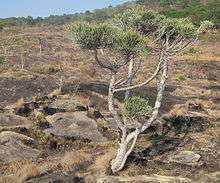Euphorbia tirucalli
Euphorbia tirucalli (commonly known as aveloz, Indian tree spurge, naked lady, pencil tree, pencil cactus, milk bush[2]) is a tree that grows in semi-arid tropical climates. A hydrocarbon plant, it produces a poisonous latex that can cause blindness.[3]
| Euphorbia tirucalli | |
|---|---|
 | |
| Mature tree in Mozambique | |
| Scientific classification | |
| Kingdom: | Plantae |
| Clade: | Tracheophytes |
| Clade: | Angiosperms |
| Clade: | Eudicots |
| Clade: | Rosids |
| Order: | Malpighiales |
| Family: | Euphorbiaceae |
| Genus: | Euphorbia |
| Species: | E. tirucalli |
| Binomial name | |
| Euphorbia tirucalli | |
Description
The pencil tree is a shrub or small tree with pencil-thick, green, smooth, succulent branches that reaches heights of growth of up to 7 meters. It has a cylindrical and fleshy stem with fragile succulent twigs that are 7 mm thick, often produced in whorls, longitudinally, finely striated. The oval leaves are 1 to 2.5 cm long and about 3 to 4 mm wide; they usually fall off early. It contains a milky, toxic and corrosive sap. The yellow flowers are at the ends of the branches.[4]
Habitat
It has a wide distribution in Africa in black clay soils, being prominently present in northeastern, central and southern Africa. It may also be native in other parts of the continent as well as some surrounding islands and the Arabian peninsula and has been introduced to many other tropical regions, such as Brazil, India, Vietnam, the Philippines and Ghana. It grows in dry areas, especially the savanna, and is often used to feed cattle or as hedging.[1] It is well known in Sri Lanka where it is called Kalli in Tamil, as mentioned in the Akananuru by the Sri Lankan Tamil poet Eelattu Poothanthevanar and in Sinhala: වැරදි නවහන්දි, ගස් නවහන්දි Weradi Navahandi or Gass Nawahandi.[5]
Toxicology
The milky latex from E. tirucalli is extremely irritating to the skin and mucosa and is toxic.[6] Exposure to it can cause blindness. Skin contact causes severe irritation, redness and a burning sensation. If ingested, it can cause burns to the mouth, lips and tongue. It is suggested to wear eye protection gear and gloves for handling the plant.
Traditional medicine
Euphorbia tirucalli is used as alternative medicine in many cultures. Attempts have been made to use it to treat cancer, excrescence, tumors, warts, asthma, cough, earache, neuralgia, rheumatism, and toothaches in countries including Brazil, India, Indonesia, and Malaysia[7].[8]
Euphorbia tirucalli has been promoted as an anticancer agent, but research shows that it suppresses the immune system, promotes tumor growth, and leads to the development of certain types of cancer.[6] Euphorbia tirucalli has also been associated with Burkitt's lymphoma and is thought to be a cofactor of the disease rather than a treatment.[9]
Uses
Its latex can also be used as fuel. This led chemist Melvin Calvin to propose the exploitation of E. tirucalli for producing oil. This usage is particularly appealing because of the ability of E. tirucalli to grow on land that is not suitable for most other crops. Calvin estimated that 10 to 50 barrels of oil per acre was achievable. In the 1980s the Brazilian national petroleum company Petrobras began experiments based these ideas. It has also been used in the production of rubber, but neither have been very successful.[1]
Gallery

Botanical illustration 
'Sticks-on-fire' 
Mature tree in Tanzania 
Golden form  View of a tree-bearing plant
View of a tree-bearing plant Cultivated plant
Cultivated plant
See also
- List of ineffective cancer treatments
- List of vegetable oils
- Biodiesel
References
- Haevermans (2004). "Euphorbia tirucalli". IUCN Red List of Threatened Species. 2004. Retrieved 11 May 2006.CS1 maint: ref=harv (link) Database entry includes justification for why this species is of least concern
- "Euphorbia tirucalli L." Germplasm Resources Information Network (GRIN). Agricultural Research Service (ARS), United States Department of Agriculture (USDA). Retrieved 16 March 2010.
- http://www.fox13news.com/health/man-hospitalized-after-encounter-with-pencil-cactus-plant
- Wolfgang Franke: Agricultural crops. Usable crops of temperate latitudes, subtropics and tropics . 6th, revised and expanded edition. Thieme, Stuttgart 1997, ISBN 3-13-530406-X
- Ayurveda Plants of Sri Lanka
- "Aveloz". American Cancer Society. Archived from the original on 26 April 2015. Retrieved 28 March 2013.
- (in Malay) Tumbuhan-tumbuhan perubatan herba, P.13
- Euphorbia tirucalli L. in Handbook of Energy Crops, James Duke
- van den Bosch C, Griffin BB, Gazembe B, Dziweni C, Kadzamira L (1993). "Are plant factors a missing link in the evolution of endemic Burkitt's lymphoma?". Br J Cancer. 68 (6): 1232–1235. doi:10.1038/bjc.1993.510. PMC 1968631. PMID 8260378.
